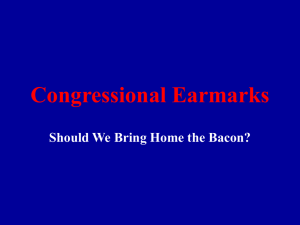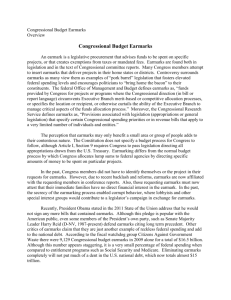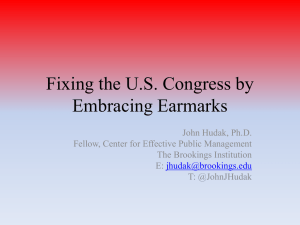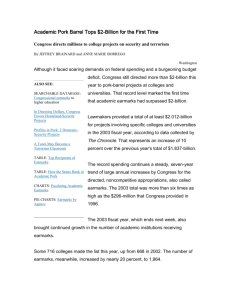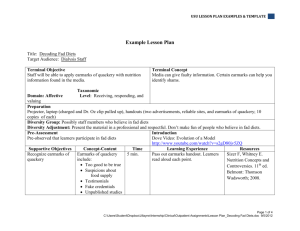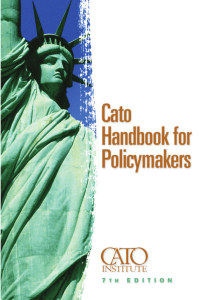Peering Inside the Pork Barrel
advertisement
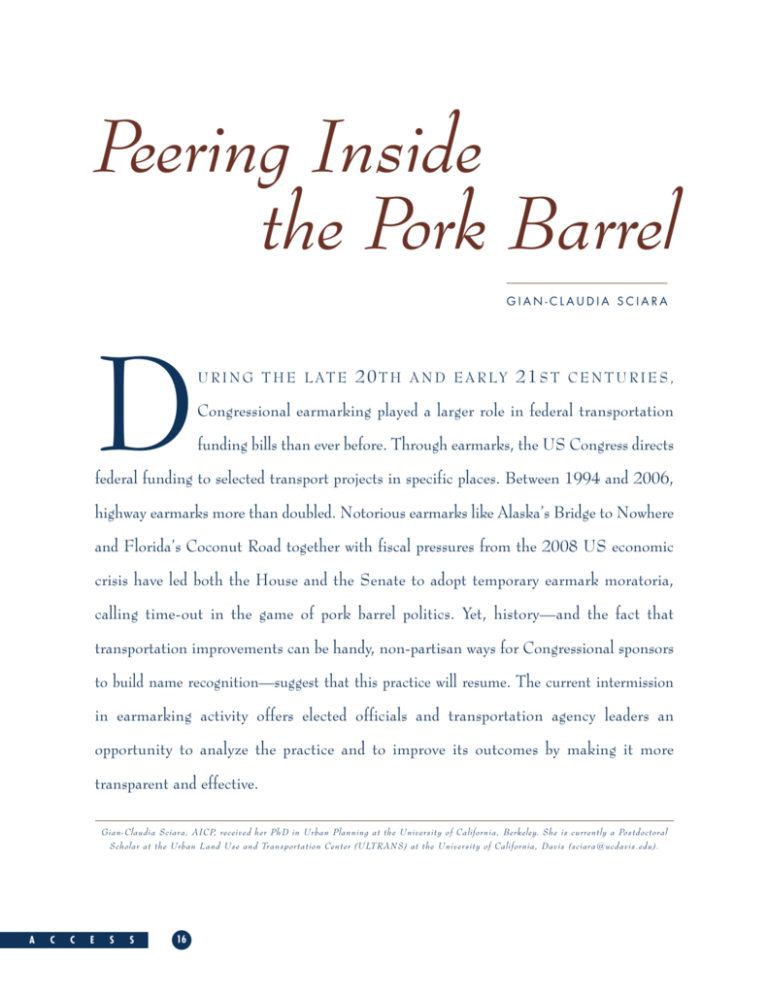
Peering Inside the Pork Barrel GIAN-CLAUDIA SCIARA D U R I N G T H E L AT E 20TH AND EARLY 21ST CENTURIES, Congressional earmarking played a larger role in federal transportation funding bills than ever before. Through earmarks, the US Congress directs federal funding to selected transport projects in specific places. Between 1994 and 2006, highway earmarks more than doubled. Notorious earmarks like Alaska’s Bridge to Nowhere and Florida’s Coconut Road together with fiscal pressures from the 2008 US economic crisis have led both the House and the Senate to adopt temporary earmark moratoria, calling time-out in the game of pork barrel politics. Yet, history—and the fact that transportation improvements can be handy, non-partisan ways for Congressional sponsors to build name recognition—suggest that this practice will resume. The current intermission in earmarking activity offers elected officials and transportation agency leaders an opportunity to analyze the practice and to improve its outcomes by making it more transparent and effective. Gian-Claudia Sciara, AICP, received her PhD in Urban Planning at the University of California, Berkeley. She is currently a Postdoctoral Scholar at the Urban L and Use and Transportation Center (ULTR ANS) at the University of California, Davis (sciara@ucdavis.edu). A C C E S S 16 Understanding the earmarking process is critical given the high stakes for any elected official or transportation agency interested in securing or spending federal funds. Earmarks transfer discretion over federal funds from local, metropolitan, state, and federal officials to members of Congress. Without earmarks, most federal dollars are available for states and metropolitan areas to fund projects they prioritize through their own selection processes. In contrast, members of Congress use earmarks to hand-pick transportation projects that may or may not reflect planning priorities articulated in metropolitan and state long range plans (LRPs) or near-term capital programs known as transportation improvement programs (TIPs). Earmarks for projects outside these priorities create challenges for regional and state transportation agencies and local governments, yet many transportation stakeholders are unfamiliar with congressional earmarking practices and their planning and financial consequences. Outsiders have little ability to observe Congress’s process for selecting transport earmarks. Furthermore, while journalistic accounts often suggest that all earmarks deliver a funding windfall, in reality, they can create unforeseen costs for transportation organizations. What can elected officials and agency leaders learn about earmarking now to plan more effectively for transportation investments when earmarks find favor again? How can members of Congress adjust their own practices to make future earmarks more transparent, more compatible with planned investments, and perhaps even better able to bolster politicians’ job approval? To answer these questions, I provide a guide to how the transportation pork barrel operated during its peak and discuss the three key steps of Congressional earmarking. I also show how key distinctions among earmarks can determine who wins or loses and whether the underlying project reaches completion. Most importantly, I consider how members of Congress, congressional committees, transportation agencies, and local government officials can harmonize the impulse to earmark with the impetus for regional and state transport planning. To create this guide, I analyzed transportation spending bills and other archival materials and interviewed federal, state, and local agencies, transportation policy organizations, Congressional committee staff, and lobbyists. Here is what I learned. ➢ TAB L E 1 Appropriation Fiscal Year Number of Earmarks Total Value of Earmarks Total Transportation Appropriation Constant $ 2010 (millions) Constant $ 2010 (millions) Earmarks as % of Total Appropriation 1994 140 $1,261 $53,555 2.4% 1996 167 $1,052 $49,367 2.1% 1998 147 $1,587 $54,563 2.9% 2000 641 $1,606 $62,734 2.6% 2002 1,493 $3,871 $71,687 5.4% 2004 2,282 $3,859 $67,556 5.7% 2006 1,541 $3,487 $65,272 5.3% 2008 1,271 $1,376 $71,375 1.9% 2010 1,038 $1,324 $76,860 1.7% Congressional Earmarks in Transportation Appropriation Bills 17 A C C E S S NUMBER 41, FALL 2012 T HE T HREE S TAGES OF E ARMARKING The precise path of any earmark is unique but generally unfolds in three stages as the bill passes through Congress. In the first step, members of Congress submit requests to the committees handling the transportation funding bills. As earmarks proliferated in the 1990s and early 2000s, the committees of jurisdiction formalized earmark request procedures, asking members to submit standard request forms first on paper, later on computer disk, and, ultimately, via Congressional intranet. Computer technology has We’ll give you $10 million. simultaneously enabled and responded to earmarking’s dramatic increase. Under the old system of maintaining requests on alphabetized index cards, keeping track of the 6,000-plus earmarks in the 2005 Safe, Accountable, Flexible, Efficient Transportation Equity Act: A Legacy for Users (SAFETEA-LU) would have been impossible. Today’s technology allows committee staff to manage far greater volumes of project requests How do you when drafting bills and to collect more information about candidate projects. In principle, want that into the earmarking process and to ensure, for example, that earmarked projects reflect allocation spent? this information should allow committees to bring technical and planning considerations planning priorities, are financially feasible, and possess environmental clearances and public support. In practice, this has not occurred. As individual members of Congress propose candidate projects, Congressional leadership sets the framework for earmarking in a funding bill. In this second step of the earmarking process, leaders of authorization and appropriation committees define how much money to devote to earmarks, what programs or accounts are eligible, the split of funds for the majority and minority political parties, and, ultimately, the share available for individual members’ earmarks. Congress does not openly deliberate these choices. Instead their decisions often reflect institutionalized practices. Little room exists, therefore, for state and regional bodies, local governments, and transportation agencies that might receive earmarks to influence this phase of the process. However, with greater knowledge of the earmarking process, transportation stakeholders can anticipate the chances of their congressional delegation securing earmarks and the impact of earmarking patterns on their share of federal funds. A C C E S S 18 In the annual appropriation, for instance, the subcommittee chairman—a “cardinal”— and the ranking minority member lay the ground rules for earmarking the bill. The majority party typically claims the greater share of funds, but the split can vary from year to year and between House and Senate chambers. Additionally, members of the key committees and subcommittees have greater access to earmarks than other members. To determine other members’ earmark allotments, the committee may weigh their seniority, other leadership positions, and electoral vulnerability. Partisan or personal issues may also figure in, such as “who’s been naughty or nice, who’s helped [the committee], and who’s pissed the chairman off,” explained one interviewee. In the third and final phase of the earmarking process, individual Congress members identify their priority projects for earmarks, and the committee staff matches those requests with available funds. As House and Senate committees finalize the bill, committee staff inform members of their earmark budgets. “The member may have requested 40 projects worth $100 million,” explained one Washington observer, “but the staff says, ‘We’ll give you $10 million. How do you want that allocation spent?’” The member then ranks what projects to include in his or her allotment, affecting what projects appear in the final bill. A member may keep silent about this invisible step to avoid telling a constituent group that its desired project was not a priority in the final round. Members’ final earmark choices reflect different values and preferences. Members may concentrate funds on a few projects or spread their allotment among many. Some members refuse to choose among projects, insisting instead that local transportation stakeholders together prioritize a regional set of desired projects. Still others may focus on a specific project while some may not pursue earmarks at all, or at least claim not to. House members may prefer to earmark projects located within their districts, whereas Senators may focus on larger projects that distribute benefits more widely across the state. In the messy process of a bill’s final passage, committees make quick decisions and may change earmarks or add them at the last minute, a practice called air-dropping. Conference committee staff and members finalize the bill under great time pressure and can make mistakes, inadvertently omitting or editing earmarks. Congress can address these errors administratively or in a technical corrections bill, when they add language to clarify mishandled projects. VARIETIES OF E ARMARKS To casual observers, earmarks appear all alike, delivering extra funds to pet projects. Yet, significant differences among earmarks can impact an underlying project’s fate and an earmark’s status as boon or bane to stakeholders. Congress earmarks funds in transport spending bills primarily by creating new demonstration programs or by earmarking existing programs, producing different winners and losers among executive agencies, state transportation departments, and federal funding applicants. For example, Congress may build a new program ultimately just for earmarking. Earmarks in such demonstration or priority project programs are said to showcase new technologies or deliver nationally significant transportation investments. Congress designates such earmarks “above the line” or “below the line.” Above-the-line demonstration projects come in addition to the share of federal highway funds guaranteed under state-to-state funding-equity provisions, while below-the-line projects come at the expense of them. Thus, below-the-line projects can shift dollars from planned state and ➢ 19 A C C E S S NUMBER 41, FALL 2012 metropolitan investments to congressionally-selected projects. Both types of earmarked projects can recast the distribution of federal funds among states and within single states. Another example is when Congress uses established discretionary programs to support earmarks. Federal agencies typically award discretionar y funds based on programmatic objectives and competitive selection criteria. Earmarks, however, “take away the executive branch’s ability to choose projects,” explained a former Federal Highway Administration official. Discretionary earmarks can benefit those agencies and governments well positioned to receive earmarks vis-à-vis their Congressional delegation, but they disadvantage those whose projects would compete strongly for funding under program objectives. Transportation earmarks also differ based on whether they appear in authorization or appropriation bills. Authorization bills structure federal transportation spending and Seasoned policy over a multi-year period, whereas the annual appropriation bill makes the year’s earmark-seekers izations infrequently, authorization earmarks are well-suited for projects under develop- recommend installment of authorized funds available for spending. Since Congress passes authorment that can gradually use annual installments for five to six years. In contrast, earmarked appropriation funds typically expire after a year or so, and are better suited to construction-ready projects. Earmark-seekers may pursue authorization or appropriation funds accordingly, or target the legislative process in which their representative or vaguely worded earmarks without references to specific tasks that could later prove unworkable. lobbyist has more influence. E ARMARKS ’ L EG AL U NDERPINNINGS What recourse do federal or state agencies, regional planning bodies, or local governments have when they object to a Congressional earmark? That depends. Overall, Congress has strategically phrased and positioned earmarking language in bills to guard its prerogative. Yet earmarks vary by whether they legally bind recipients to develop the project as Congress directs. Such variation determines the amount of flexibility earmark recipients or oversight agencies have to shape, amend, or reject an earmarked project. Recipients must spend so-called “statutory earmarks” as they appear directly in the law’s text or its accompanying conference report, even though a transportation project can evolve in the period between the passage of a bill and the use of its earmarked funds. If the description in the original earmark no longer matches the project a grant recipient intends to implement, Congress must adjust the legislation. Non-statutory earmarks are easier to adjust than statutory earmarks. In either case, adjustments can burden agencies by absorbing significant staff time and political capital. If adjustments are not possible, an earmark recipient must spend the funds as prescribed or risk losing them. Seasoned earmark-seekers thus recommend vaguely worded earmarks without references to specific tasks that could later prove unworkable. Projects that Congress earmarks sometimes do not align with the federal program designated to pay for them. The federal bus assistance program, for instance, is intended to support bus purchases, but some earmarks have directed those funds to unrelated projects. Federal agencies can block earmarks that violate a program’s legal funding criteria, but they may be reluctant to do so, fearing reduced budgets due to Congressional retaliation. To further prevent such challenges, Congress employs earmarking language to ensure an earmark will proceed “notwithstanding any other provision of law.” A C C E S S 20 T RANSFORMING E ARMARKING P RACTICE The Congressional earmarking process is dynamic. For parties who seek, administer, or use federal transportation funds, careful understanding of earmarking is paramount. Authorizers, appropriators, executive agencies, and earmark-seekers continually adapt earmarking practices in response to opportunities and threats. Each shift influences the types of earmarks created, their legal status, and their impacts on underlying projects and the agencies implementing them. For instance, although both houses of Congress recently adopted bans on earmarking, the wording of both moratoria suggests that Congress can still direct federal funds to specific projects, provided such actions fall outside the technical definition of earmarks. Thus, so-called “soft” earmarks, which identify specific projects but not specific dollar amounts, may prevail. Members of Congress may also increase direct telephone and letter appeals to federal transportation agencies to fund desired projects, processes termed “phone-marking” and “letter-marking.” Economic stagnation and political winds favoring federal cuts may extend Congress’s hesitation to earmark in the near term. Over the long term, however, Congress will likely reintroduce designations for special projects, which may result in new, potentially less transparent forms of earmarking. As one observer remarked, “When one door closes, there are always two or three more that they can go through.” Thus, stakeholders must remain attentive to the evolving practice of congressional earmarking. Understanding past earmarking processes can provide insight on how to improve and streamline future earmarks. To start, congressional committees that draft transport funding bills could decline requests for projects that have not come through established ➢ 21 A C C E S S NUMBER 41, FALL 2012 FURTHER READING planning processes and do not appear in approved regional or state transportation improvement programs. The TIP of a metropolitan area or state lists federally funded Ann Brach and Martin Wachs. 2005. “Earmarking in the U.S. Department of Transportation Research Programs,” Transportation Research Part A: Policy and Practice, 39(6): 501–521. projects and programs ready for near-term implementation. By insisting that earmark Diana Evans. 2004. Greasing the Wheels: Using Pork Barrel Projects to Build Majority Coalitions in Congress, Cambridge, UK: Cambridge University Press. avoid the planning, financial, administrative, and legal complications of non-TIP earmarks, candidates come from the TIP, committees could ensure that they earmark only those projects already vetted via public planning processes. Individual Congress members interested in good government could adopt this custom too. The practice could not only but also make the earmarking process more transparent. Whatever Congress does, transportation agencies and local governments can initiate and sustain efforts to educate congressional delegations and their staffs about TIP Gian-Claudia Sciara. 2012. “Financing Congressional Earmarks: Implications for Transport Policy and Planning,” Transportation Research Part A: Policy and Practice, 46(8): 1328–1342. programs and projects. Without violating ethical norms that discourage lobbying by public agencies, local government and agency officials could inform members of Congress about transport projects that are high priorities in regional and state plans. They could also explain how earmarks outside those priorities might affect planned regional Gian-Claudia Sciara. 2012. “Peering Inside the Pork Barrel: A Study of Congressional Earmarking in Transportation,” Public Works Management & Policy, 17(3): 217–237. Gian-Claudia Sciara. 2012. “Planning for Unplanned Pork: The Consequences of Congressional Earmarking for Regional Transportation Planning,” Journal of the American Planning Association, 78(3): 239–255. Gian-Claudia Sciara. 2009. “Earmark Pursuit Practices of Metropolitan Planning Organizations and Their Members,” Transportation Research Record, 2119: 58–65. and state transport system improvements. These measures could make earmarking work more in concert with regional and state transport investment plans instead of against them. Of course, defenders contend that earmarks democratize the distribution of federal transportation funds, allowing stakeholders to advance projects in the face of regional and state planning processes that they view as inadequate or unfair. Where planning processes and bodies themselves need improvement, however, the ability to sidestep them with earmarks ultimately diminishes the urgency for reform. Earmarks for projects drawn from regional and state TIPs also stand to enhance the very credit-claiming and name-branding opportunities for which representatives typically seek earmarks. Projects chosen from established plans and with stakeholder consultation are more likely to be well developed and have planning and environmental reviews in place. In such cases, a well-considered earmark could speed project delivery, realize the project’s public benefits sooner, and make the desired ribbon cutting a safer bet. Therefore, although congressional earmarking is unlikely ever to disappear completely, its dynamic character allows for transformative changes. With thoughtful action, stakeholders can make future earmarking more transparent and effective, to everyone’s benefit. ◆ This article is adapted from the longer version, “Peering Inside the Pork Barrel: A Study of Congressional Earmarking in Transportation,” originally published in Public Works Management and Policy. A C C E S S 22
